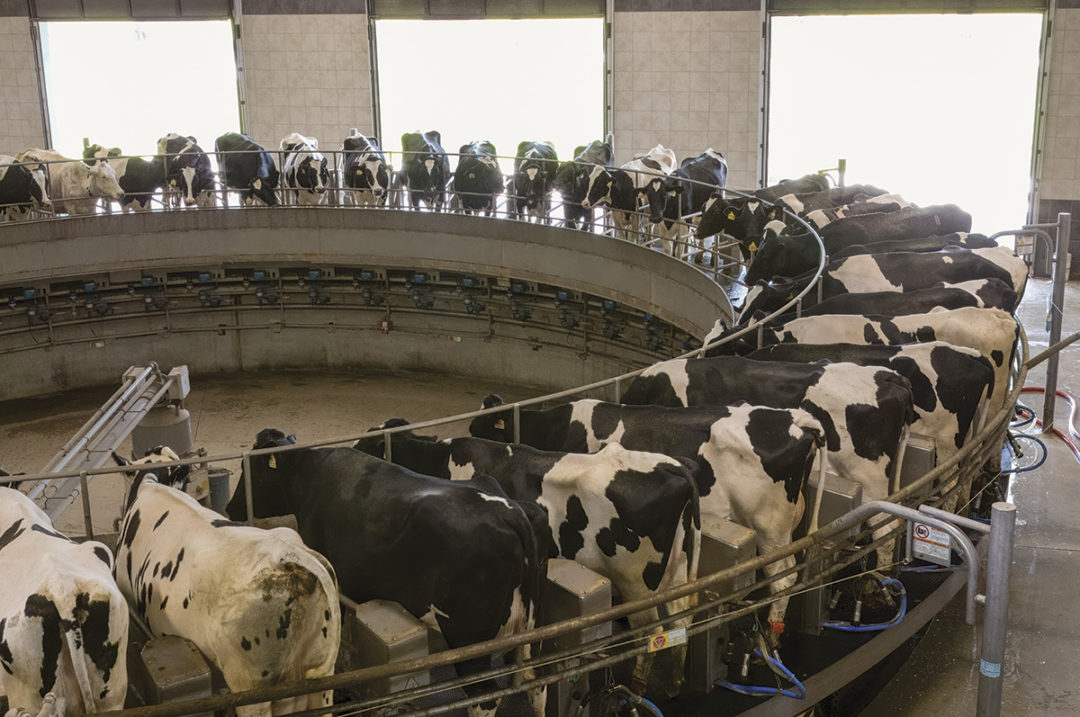The USDA released results from the 2022 Census of Agriculture showing that large farms are getting larger, small farms are growing in number and those in the middle are exiting.
In the dairy industry, farm numbers are projected to decline to 18,000 dairies by 2030, while milk production trends have been on the rise. To continue meeting consumer demand, successful producers must invest in their operations, including their milking systems.
Deciding to go internal or external with a rotary parlor?
Deciding to invest in a rotary parlor will set the course for your business for the next two decades (or more).
When deciding between internal and external rotary milking systems, dairy producers must assess their unique needs, operational goals and budget constraints.
Labor availability, future expansion plans and management practices most often guide the decision-making process when it comes to capital investments for a new rotary parlor.
Internal rotary milking systems: Embracing automation and efficiency
Upgrading from a stanchion or parallel milking system is a major way to lessen labor demands.
Typically, internal rotary systems are going to milk with one to two people for between two and five hours on each shift. So, if you have a small family operation with three to five people on the entire farm, making an upgrade to an internal rotary often works well.
The internal rotary system is also the most flexible for future expansion on small- to mid-sized farms.
For example, there are 24-, 32- and 40-stall internal rotary systems available, which will turn roughly five to five-and-a-half turns per hour. This allows an operation to milk 120 to 220 cows per hour depending on the platform size. It's great for a family farm or a small- to medium-sized operation due to its expandability and flexibility.
As we look to the future of internal systems, many current users are former stanchion barn or parallel parlor customers who are easing the labor challenges that dairies have faced in the last three to five years. The technology, and getting a system that allows the dairy producer to milk with less labor, is going to be big for them.
Another advantage of the internal rotary is the central viewing point.
With an internal rotary, the milker stands in the center of the circle, and the cows are positioned sideways, offering excellent viewing in an internal system. This provides the farm manager roughly a 10-minute view of each animal on every shift, compared to external systems where only the rears of three to five cows are visible at a time. This helps producers keep an eye on every cow every day.
External milking systems: Designed for durability and reliability at scale
Externals are much more common in the industry and are typically used on commercial dairies where consolidation is increasing farm sizes. Farms with over 1,000 cows are becoming more common as dairies buy up others and consolidate. These heavy-duty platforms often run over 18 to 20 hours per day and require three to five people to milk the cows.
These setups are designed with robust construction and engineering to handle the high daily headcount.
As dairy operations consolidate and scale up, these systems offer the capacity and efficiency required to meet production demands.
While external systems require three to five employees, experienced milkers can closely monitor individual cows with the rear-cow view. This allows a trained eye to quickly identify health concerns with the help of automated monitoring systems.
For commercial dairy producers who need reliable, high-volume milking systems, external milking systems remain the preferred choice.
Automation tech and maintenance vary little between systems
The advantages of both the internal and external rotary parlor include opportunities to upgrade technology and automation.
Automation, such as milk metering to enhance milking efficiency, is often available for both systems.
Maintaining rotary milking systems is crucial for their longevity and efficient operation.
While a rotary parlor may seem labor intensive, regular greasing and alignment checks ensure smooth functioning for the long term. Producers should work with their dealers for regular maintenance. An evergreen program in partnership with select dealers offers cluster exchange (claw, liner and shell) and pulsation exchange. This service benefits the dairy through continuous, optimal performance of equipment during the year, allowing the dairy to plan its annual investment for routine service upfront.
With regular maintenance, your investment in your new rotary milking system can last a long time.
Despite their complexity, external rotaries have shown durability, with many operating effectively for over 15 years – even when under challenging conditions, such as sand bedding.
Making the move to enhance productivity
The choice between internal and external milking systems can shape a herd’s operations for years to come. Understanding and taking charge of management practices and labor availability is vital amid industry shifts. Whether investing in an internal system for small- or mid-sized operation efficiency or an external system for durability and scale, rotary parlor options enhance productivity.







